

Tautology. From Wikipedia, the free encyclopedia Tautology may refer to:
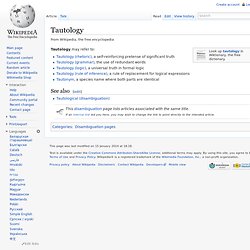
Tautology (rhetoric) Rhetorical tautologies state the same thing twice, while appearing to state two or more different things, while logical tautologies state the same thing twice and must do so by logical necessity.

The inherent meanings and subsequent conclusions in rhetorical and logical tautologies or logical necessities are very different. Logical tautologies are neither refutable nor verifiable under any condition by axiomatic necessity. All world views contain circularity in terms of the Münchhausen_trilemma or Bootstrapping trilemma. It is included on the List of unsolved problems in philosophy and it is a major concern for many contemporary epistemologists. [1] The trilemma raises the question as whether all circularity is fallacious. Aristotle's "begging the question", "begging the premise" or "requesting the premise" means a conclusion is stated without specifying the premise which is not the same concept as a circular argument.
Tautology (logic) Is sometimes used to denote an arbitrary tautology, with the dual symbol (falsum) representing an arbitrary contradiction.
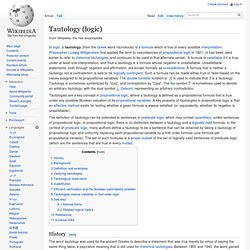
Tautologies are a key concept in propositional logic, where a tautology is defined as a propositional formula that is true under any possible Boolean valuation of its propositional variables. A key property of tautologies in propositional logic is that an effective method exists for testing whether a given formula is always satisfied (or, equivalently, whether its negation is unsatisfiable). In 1800, Immanuel Kant wrote in his book Logic: "The identity of concepts in analytical judgments can be either explicit (explicita) or non-explicit (implicita). Here analytic proposition refers to an analytic truth, a statement in natural language that is true solely because of the terms involved. In 1884, Gottlob Frege proposed in his Grundlagen that a truth is analytic exactly if it can be derived using logic. And representing negation, the following formula can be obtained:: . . Tautology (rule of inference) In propositional logic, tautology is one of two commonly used rules of replacement.[1][2][3] The rules are used to eliminate redundancy in disjunctions and conjunctions when they occur in logical proofs.
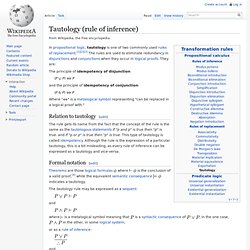
They are: The principle of idempotency of disjunction: and the principle of idempotency of conjunction: Where " Theorems are those logical formulas where. Lexicon. Formally, in linguistics, a lexicon is a language's inventory of lexemes.
The word "lexicon" derives from the Greek λεξικόν (lexicon), neuter of λεξικός (lexikos) meaning "of or for words".[1] Linguistic theories generally regard human languages as consisting of two parts: a lexicon, essentially a catalogue of a language's words (its wordstock); and a grammar, a system of rules which allow for the combination of those words into meaningful sentences. The lexicon is also thought to include bound morphemes, which cannot stand alone as words (such as most affixes). In some analyses, compound words and certain classes of idiomatic expressions and other collocations are also considered to be part of the lexicon. Ontology (information science) In computer science and information science, an ontology formally represents knowledge as a hierarchy of concepts within a domain, using a shared vocabulary to denote the types, properties and interrelationships of those concepts.[1][2] Ontologies are the structural frameworks for organizing information and are used in artificial intelligence, the Semantic Web, systems engineering, software engineering, biomedical informatics, library science, enterprise bookmarking, and information architecture as a form of knowledge representation about the world or some part of it.
The creation of domain ontologies is also fundamental to the definition and use of an enterprise architecture framework. The term ontology has its origin in philosophy and has been applied in many different ways. The word element onto- comes from the Greek ὤν, ὄντος, ("being", "that which is"), present participle of the verb εἰμί ("be"). According to Gruber (1993): Common components of ontologies include: Generic Model Organism Database. Generic Model Organism Database project logo The Generic Model Organism Database (GMOD) project provides biological research communities with a toolkit of open-source software components for visualizing, annotating, managing, and storing biological data.
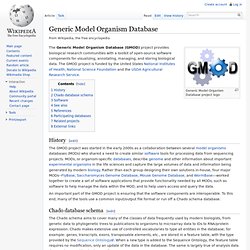
The GMOD project is funded by the United States National Institutes of Health, National Science Foundation and the USDA Agricultural Research Service. History[edit] The GMOD project was started in the early 2000s as a collaboration between several model organisms databases (MODs) who shared a need to create similar software tools for processing data from sequencing projects. MODs, or organism-specific databases, describe genome and other information about important experimental organisms in the life sciences and capture the large volumes of data and information being generated by modern biology. An important part of the GMOD project is ensuring that the software components are interoperable. Chado database schema[edit] Software[edit] Taxonomy (general) Taxonomy is the practice and science of classification.
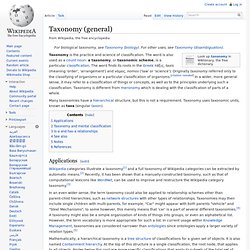
The word is also used as a count noun: a taxonomy, or taxonomic scheme, is a particular classification. The word finds its roots in the Greek τάξις, taxis (meaning 'order', 'arrangement') and νόμος, nomos ('law' or 'science').